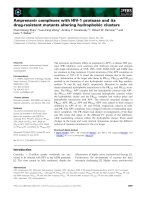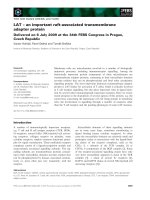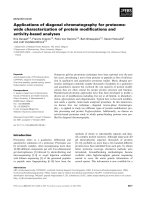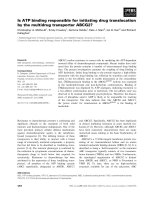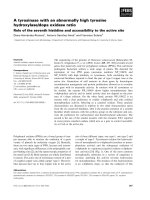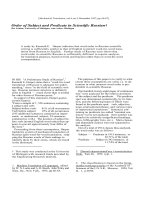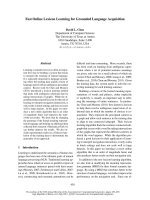Tài liệu Báo cáo khoa học: "Context Management with Topics for Spoken Dialogue Systems" pptx
Bạn đang xem bản rút gọn của tài liệu. Xem và tải ngay bản đầy đủ của tài liệu tại đây (665.34 KB, 7 trang )
Context Management with Topics for Spoken Dialogue Systems
Kristiina Jokinen
and Hideki Tanaka and Akio
Yokoo
ATR Interpreting Telecommunications Research Laboratories
2-2 Hikaridai, Seika-cho, Soraku-gun
Kyoto 619-02 Japan
email : {kj okinen[tanakah[ayokoo}~itl, air. co. jp
Abstract
In this paper we discuss the use of discourse con-
text in spoken dialogue systems and argue that the
knowledge of the domain, modelled with the help of
dialogue topics is important in maintaining robust-
ness of the system and improving recognition accu-
racy of spoken utterances. We propose a topic model
which consists of a domain model, structured into a
topic tree, and the Predict-Support algorithm which
assigns topics to utterances on the basis of the topic
transitions described in the topic tree and the words
recognized in the input utterance. The algorithm
uses a probabilistic topic type tree and mutual infor-
mation between the words and different topic types,
and gives recognition accuracy of 78.68% and preci-
sion of 74.64%. This makes our topic model highly
comparable to discourse models which are based on
recognizing dialogue acts.
1 Introduction
One of the fragile points in integrated spoken lan-
guage systems is the erroneous analyses of the initial
speech input. 1 The output of a speech recognizer has
direct influence on the performance of other mod-
ules of the system (dealing with dialogue manage-
ment, translation, database search, response plan-
ning, etc.), and the initial inaccuracy usually gets
accumulated in the later stages of processing. Per-
formance of speech recognizers can be improved by
tuning their language model and lexicon, but prob-
lems still remain with the erroneous ranking of the
best paths: information content of the selected ut-
terances may be wrong. It is thus essential to use
contextual information to compensate various errors
in the output, to provide expectations of what will
be said next and to help to determine the appropri-
ate dialogue state.
However, negative effects of an inaccurate context
have also been noted: cumulative error in discourse
context drags performance of the system below the
rates it would achieve were contextual information
1 Alexandersson (1996) remarks that with a 3000 word lex-
icon, a 75 % word accuracy means that in practice the word
lattice does not contain the actually
spoken sentence,
not used (Qu et al., 1996; Church and Gale, 1991).
Successful use of context thus presupposes appro-
priate context management: (1) features that define
the context are relevant for the processing task, and
(2) construction of the context is accurate.
In this paper we argue in favour of using one
type of contextual information, topic information,
to maintain robustness of a spoken language sys-
tem. Our model deals with the
information content
of utterances, and defines the context in terms of
topic types,
related to the current domain knowl-
edge and represented in the form of a topic tree.
To update the context with topics we introduce the
Predict-Support algorithm which selects utterance
topics on the basis of topic transitions described in
the topic tree and words recognized in the current
utterance. At present, the algorithm is designed as
a filter which re-orders the candidates produced by
the speech recognizer, but future work encompasses
integration of the algorithm into a language model
and actual speech recognition process.
The paper is organised as follows. Section 2 re-
views the related previous research and sets out our
starting point. Section 3 presents the topic model
and the Predict-Support algorithm, and section 4
gives results of the experiments conducted with the
model. Finally, section 5 summarises the properties
of the topic model, and points to future research.
2 Previous
research
Previous research on using contextual information
in spoken language systems has mainly dealt with
speech acts (Nagata and Morimoto, 1994; Reithinger
and Maier, 1995; MSller, 1996). In dialogue sys-
tems, speech acts seem to provide a reasonable first
approximation of the utterance meaning: they ab-
stract over possible linguistic realisations and, deal-
ing with the illocutionary force of utterances, can
also be regarded as a domain-independent aspect of
communication. 2
2Of course, most dialogue systems include domain depen-
dent acts
to cope with the
particular requirements
of the
do-
main, cf.Alexandersson (1996). Speech acts are also related
to
the task: information providing,
appointment negotiat-
631
However, speech acts concern a rather abstract
level of utterance modelling: they represent the
speakers' intentions, but ignore the semantic con-
tent of the utterance. Consequently, context models
which use only speech act information tend to be
less specific and hence less accurate. Nagata and
Morimoto (1994) report prediction accuracy of 61.7
%, 77.5 % and 85.1% for the first, second and third
best dialogue act (in their terminology: Illocution-
ary Force Type) prediction, respectively, while Rei-
thinger and Maier (1995) report the corresponding
accuracy rates as 40.28 %, 59.62 % and 71.93 %,
respectively. The latter used structurally varied di-
alogues in their tests and noted that deviations from
the defined dialogue structures made the recognition
accuracy drop drastically.
To overcome prediction inaccuracies, speech act
based context models are accompanied with the in-
formation about the task or the actual words used.
Reithinger and Maier (1995) describe plan-based re-
pairs, while MSller (1996) argues in favour of domain
knowledge. Qu et al. (1996) show that to minimize
cumulative contextual errors, the best method, with
71.3% accuracy, is the Jumping Context approach
which relies on syntactic and semantic information
of the input utterance rather than strict prediction of
dialogue act sequences. Recently also keyword-based
topic identification has been applied to dialogue
move (dialogue act) recognition (Garner, 1997).
Our goal is to build a context model for a spo-
ken dialogue system, and we emphasise especially
the system's
robustness,
i.e. its capability to pro-
duce reliable and meaningful responses in presence
of various errors, disfluencies, unexpected input and
out-of-domain utterances, etc. (which are especially
notorious when dealing with spontaneous speech).
The model is used to improve word recognition ac-
curacy, and it should also provide a useful basis for
other system modules.
However, we do not aim at robustness on a merely
mechanical level of matching correct words, but
rather, on the level of maintaining the
information
content
of the utterances. Despite the vagueness
of such a term, we believe that speech act based
context models are less robust due to the fact that
the information content of the utterances is ignored.
Consistency of the information exchanged in (task-
oriented) conversations is one of the main sources for
dialogue coherence, and so pertinent in the context
management besides speech acts. Deviations from a
predefined dialogue structure, multifunctionality of
utterances, various side-sequences, disfluencies, etc.
cannot be dealt with on a purely abstract level of
illocution, but require knowledge of the domain, ex-
pressed in the semantic content of the utterances.
ion, argumentation etc. have different communicative pur-
poses which are reflected in the set of necessary speech acts.
Moreover, in multilingual applications, like speech-
to-speech translation systems, the semantic content
of utterances plays an important role and an inte-
grated system must also produce a semantic analysis
of the input utterance. Although the goal may be a
shallow understanding only, it is not enough that the
system knows that the speaker uttered a "request":
the type of the request is also crucial.
We thus reckon that appropriate context manage-
ment should provide descriptions of what is said,
and that the recognition of the utterance topic is an
important task of spoken dialogue systems.
3 The Topic Model
In AI-based dialogue modelling, topics are associ-
ated with a particular discourse entity,
focus,
which
is currently in the centre of attention and which
the participants want to focus their actions on, e.g.
Grosz and Sidner (1986). The topic (focus) is a
means to describe thematically coherent discourse
structure, and its use has been mainly supported by
arguments regarding anaphora resolution and pro-
cessing effort (search space limits). Our goal is to
use topic information in predicting likely content of
the next utterance, and thus we are more interested
in the topic
types
that describe the information con-
veyed by utterances than the actual topic entity.
Consequently, instead of tracing salient entities in
the dialogue and providing heuristics for different
shifts of attention, we seek a formalisation of the
information structure of utterances in terms of the
new information
that is exchanged in the course of
the dialogue.
The purpose of our topic model is to assist speech
processing, and so extensive and elaborated reason-
ing about plans and world knowledge is not avail-
able. Instead a model that relies on observed facts
(= word tokens) and uses statistical information is
preferred. We also expect the topic model to be gen-
eral and extendable, so that if it is to be applied to
a different domain, or more factors in the recogni-
tion of the information structure of the utterances 3
are to be taken into account, the model could easily
adapt to these changes.
The topic model consists of the following parts:
1. domain knowledge structured into a topic tree
2. prior probabilities of different topic shifts
3. topic vectors describing the mutual information
between words and topic types
4. Predict-Support algorithm to measure similar-
ity between the predicted topics and the topics
supported by the input utterance.
Below we describe each item in detail.
3For instance, sentential stress and pitch accent are im-
portant in recognizing topics in spontaneous speech.
632
Figure 1: A partial topic tree.
3.1 Topic trees
Originally "focus trees" were proposed by (McCoy
and Cheng, 1991) to trace foci in NL generation sys-
tems. The branches of the tree describe what sort
of shifts are cognitively easy to process and can be
expected to occur in dialogues: random jumps from
one branch to another are not very likely to occur,
and if they do, they should be appropriately marked.
The focus tree is a subgraph of the world knowledge,
built in the course of the discourse on the basis of
the utterances that have occurred. The tree both
constrains and enables prediction of what is likely
to be talked about next, and provides a top-down
approach to dialogue coherence.
Our topic tree is an organisation of the domain
knowledge in terms of topic types, bearing resem-
blance to the topic tree of Carcagno and Iordanskaja
(1993). The nodes of the tree 4 correspond to topic
types which represent clusters of the words expected
to occur at a particular point of the dialogue. Fig-
ure 1 shows a partial topic tree in a hotel reservation
domain.
For our experiments, topic trees were hand-coded
from our dialogue corpus. Since this is time-
consuming and subjective, an automatic clustering
program, using the notion of a topic-binder, is cur-
rently under development.
Our corpus contains 80 dialogues from the bilin-
gual ATR Spoken Language Dialogue Database.
4We will continue talking about a topic
tree,
although in
statistical modelling, the tree becomes a topic
network
where
the shift probability between nodes which are not daughters
or sisters of each other is close to zero.
The dialogues deal with hotel reservation and tourist
information, and the total number of utterances is
4228. (Segmentation is based on the information
structure so that one utterance contains only one
piece of new information.) The number of different
word tokens is 27058, giving an average utterance
length 6,4 words.
The corpus is tagged with speech acts, using a
surface pattern oriented speech act classification of
Seligman et al. (1994), and with topic types. The
topics are assigned to utterances on the basis of the
new information carried by the utterance. New in-
formation (Clark and Haviland, 1977; Vallduvl and
Engdahl, 1996) is the locus of information related to
the sentential nuclear stress, and identified in regard
to the previous context as the piece of information
with which the context is updated after uttering the
utterance. Often new information includes the verb
and the following noun phrase.
More than one third of the utterances (1747) con-
tain short fixed phrases
(Let me confirm; thank you;
good.bye; ok; yes),
and temporizers
(well, ah, uhm).
These utterances do not request or provide informa-
tion about the domain, but control the dialogue in
terms of time management requests or convention-
alised dialogue acts (feedback-acknowledgements,
thanks, greetings, closings, etc.) The special topic
type IAM, is assigned to these utterances to signify
their role in InterAction Management. The topic
type
MIX
is reserved for utterances which contain in-
formation not directly related to the domain (safety
of the downtown area, business taking longer than
expected, a friend coming for a visit etc.), thus mark-
ing out-of-domain utterances. Typically these utter-
ances give the reason for the request.
The number of topic types in the corpus is 62.
Given the small size of the corpus, this was consid-
ered too big to be used successfully in statistical cal-
culations, and they were pruned on the basis of the
topic tree: only the topmost nodes were taken into
account and the subtopics merged into approproate
mother topics. Figure 2 lists the pruned topic types
and their frequencies in the corpus.
tag
count ~ interpretation
iam 1747 41.3 Interaction Management
room 826 19.5 Room, its properties
stay 332 7.9 Staying period
name 320 7.6 Name, spelling
res 310 7.3 Make/change/extend/
cancel reservation
paym 250 5.9 Payment method
contact 237 5.6 Contact Info
meals 135 3.2 Meals (breakfast, dinner)
mix 71 1.7 Single unique topics
Figure 2: Topic tags for the experiment.
633
3.2 Topic shifts
On the basis of the tagged dialogue corpus, proba-
bilities of different topic shifts were estimated. We
used the Carnegie Mellon Statistical Language Mod-
eling (CMU SLM) Toolkit, (Clarkson and Rosen-
feld, 1997) to calculate probabilities. This builds a
trigram backoff model where the conditional proba-
blilities are calculated as follows:
p(w3[wl,
w2) =
p3(wl, w2, w3)
bo_wt2(wl,
w2) x
p(w31w2)
p(w3lw2)
if trigram exists
if bigram (wl,w2)
exists
otherwise.
p(w21wl) =
p2(wl, w2) if bigram exists
bo_wtl(wl) × pl(w2)
otherwise.
3.3 Topic vectors
Each word type may support several topics. For in-
stance, the occurrence of the word
room
in the utter-
ance
I'd like to make a room reservation,
supports
the topic MAKERESERVATION, but in the utterance
We have only twin rooms available on the 15th.
it
supports the topic ROOM. To estimate how well the
words support the different topic types, we measured
mutual information
between each word and the topic
types. Mutual information describes how much in-
formation a word w gives about a topic type t, and
is calculated as follows
(ln
is log base two,
p(tlw )
the conditional probability of t given w, and
p(t)
the probability of
t):
I(w,t)
=
In
p(w,t)
In
p(t[w)
p(w). p(t) p(t)
If a word and a topic are negatively correlated,
mutual information is negative: the word signals
absence of the topic rather than supports its pres-
ence. Compared with a simple counting whether the
word occurs with a topic or not, mutual information
thus gives a sophisticated and intuitively appealing
method for describing the interdependence between
words and the different topic types.
Each word is associated with a
topic vector,
which
describes how much information the word w carries
about each possible topic type
ti:
topvector( mi( w, t l ), mi( w, t 2 ), , mi( w, t, ) )
For instance, the topic vector of the word
room
is:
topvector (room,
[mi (0. 21409750769169117,
cont act
),
mi
(-5. 5258041314543815, iam),
mi (-3. 831955835588453 ,meals ),
mi
(0
,mix),
mi
(
ml * 2697134113673~ ~ naive )
mi
(-2.
720924523199709,
paym) ,
mi (0. 9687353561881407 ,res),
mi (I. 9035899442740105, room),
mi (-4.130179669884547, stay) ] ).
The word supports the topics ROOM and MAKE-
RESERVATION (res), but gives no information about
MIX (out-of-domain) topics, and its presence is
highly indicative that the utterance is not at least
IAM or STAY. It also supports CONTACT because
the corpus contains utterances like
I'm in room 213
which give information about how to contact the
customer who is staying at a hotel.
The topic vectors are formed from the corpus. %Ve
assume that the words are independently related to
the topic types, although in the case of natural lan-
guage utterances this may be too strong a constraint.
3.4 The Predict-Support Algorithm
Topics are assigned to utterances given the previous
topic sequence (what has been talked about) and
the words that carry new information (what is actu-
ally said). The Predict-Support Algorithm goes as
follows:
1. Prediction: get the set of likely next topics in
regard to the previous topic sequences using the
topic shift model.
2. Support: link each Newlnfo word
wj
of the in-
put to the possible topics types by retrieving
its topic vector. For each topic type ti, add up
the amounts of mutual information
rni(wj;ti)
by which it is supported by the words
wj,
and
rank the topic types in the descending order of
mutual information.
3. Selection:
(a) Default: From the set of predicted topics,
select the most supported topic as the cur-
rent topic.
(b) What-is-said heuristics: If the predicted
topics do not include the supported topic,
rely on what is said, and select the most
supported topic as the current topic (cf.
the Jumping Context approach in Qu et
al. (1996)).
(c) What-is-talked-about heuristics: If the
words do not support any topic (e.g. all the
words are unknown or out-of-domain), rely
on what is predicted and select the most
likely topic as the current topic.
3 shows schematically how the algorithm
Figure
works.
634
U 1
- w11, w12, , Wlm > T 1
U 2 - w21" w22, , W2m > T 2
U 3 - w31, w32, , W3m > T 3
Un
Prediction:
T n - max p(Tk I Tk_2Tk. 1)
Tk
m Wnl , wn2 wnm > T n
mi(W*nl .Ta) . mi('Wrt2,T a ) i(Wnm.T a )
mi(Wnl ,T b) miff,*V n2,T b) • . . mi0&'nm,T b)
rni(Wnl ,T k)
mi(Wn2,T k)
. . .
mi(Wnm,Tk)
m
Support:
mi(Un,Tk ) = ~ mi0/Vni,Tk ) T n - max mi(Un,T k)
i=l T k
Select:.
Default: T n =max ml(Un,T k) and Tn= max p(TkITk.2Tk_l)}
T k T k
Whnt/s s~/d: T n -max mi(Un,T k)
Tk
What is tnl'~d about: Tn = max p(T k I Tk.2Tk. 1 )
Tk
Figure 3: Scheme of the Predict-Support Algorithm.
Using the probabilities obtained by the trigram
backoff model, the set of likely topics is actually a
set of all topic types ordered according to their like-
lihood. However, the original idea of the topic trees
is to constrain topic shifts (transitions from a node
to its daughters or sisters are favoured, while shifts
to nodes in separate branches are less likely to oc-
cur unless the information under the current node
is exhaustively discussed), and to maintain this re-
strictive property, we take into consideration only
topics which have probability greater than an arbi-
trary limit p.
Instead of having only one utterance analysed
at the time and predicting its topic, a speech rec-
ognizer produces a word lattice, and the topic is
to be selected among candidates for several word
strings. We envisage the Predict-Support algorithm
will work in the described way in these cases as well.
However, an extra step must be added in the se-
lection process: once the topics are decided for the
n-best word strings in the lattice, the current topic
is selected among the topic candidates as the high-
est supported topic. Consequently, the word string
associated with the selected topic is then picked up
as the current utterance.
We must make two caveats for the performance
of the algorithm, related to the sparse data prob-
lem in calculating mutual information. First, there
is no difference between out-of-domain words and
unknown but in-domain words: both are treated as
providing no information about the topic types. If
such words are rare, the algorithm works fine since
the other words in the utterance usually support
the correct topic. However, if such words occur ?re-
quently, there is a difference in regard to whether
the unknown words belong to the domain or not.
Repeated out-of-domain words may signal a shift to
a new topic: the speaker has simply jumped into
a different domain. Since the out-of-domain words
do not contribute to any expected topic type, the
topic shift is not detected. On the other hand, if
unknown but in-domain words are repeated, mu-
tual information by which the topic types are sup-
ported is too coarse and fails to make necessary dis-
tinctions; hence, incorrect topics can be assigned.
For instance, if lunch is an unknown word, the ut-
terance Is lunch included? may get an incorrect
topic type ROOMPRICE since this is supported by
the other words of the utterance whose topic vec-
tors were build on the basis of the training corpus
examples like Is tax included?
The other caveat is opposite to unknown words.
If a word occurs in the corpus but only with a par-
ticular topic type, mutual information between the
word and the topic becomes high, while it is zero
with the other topics. This co-occurrence may just
be an accidental fact due to a small training cor-
pus, and the word can indeed occur with other topic
types too. In these cases it is possible that the algo-
rithm may go wrong: if none of the predicted topics
of the utterance is supported by the words, we rely
on the What-is-said heuristics and assign the highly
supported but incorrect topic to the utterance. For
instance, if included has occurred only with ROOM-
PRICE, the utterance Is lunch included? may still
get an incorrect topic, even though lunch is a known
word: mutual information mi(included, RoomPrice)
may be greater than mi(lunch, Meals).
4 Experiments
We tested the Predict-Support algorithm using
cross-validation on our corpus. The accuracy results
of the first predictions are given in Table 4. PP is
the corpus perplexity which represents the average
branching factor of the corpus, or the number of al-
ternatives from which to choose the correct label at
a given point.
For the pruned topic types, we reserved 10 ran-
domly picked dialogues for testing (each test file con-
tained about 400-500 test utterances), and used the
other 70 dialogues for training in each test cycle.
The average accuracy rate, 78.68 % is a satisfactory
result. We also did another set of cross-validation
tests using 75 dialogues for training and 5 dialogues
for testing, and as expected, a bigger training cor-
pus gives better recognition results when perplexity
stays the same.
To compare how much difference a bigger num-
ber of topic tags makes to the results, we con-
ducted cross-validation tests with the original 62
topic types. A finer set of topic tags does worsen
635
Test type PP
Topics = 10
train = 70 files 3.82
Topics = 10
train = 75 files 3.74
Topics = 62
train = 70 files 5.59
Dacts = 32
train = 70 files 6.22
PS-aigorithm BO model
78.68 41.30
80.55 40.33
64.96 41.32
58.52 19.80
Figure 4: Accuracy results of the first predictions.
the accuracy, but not as much as we expected: the
Support-part of the algorithm effectively remedies
prediction inaccuracies.
Since the same corpus is also tagged with speech
acts, we conducted similar cross-validation tests
with speech act labels. The recognition rates are
worse than those of the 62 topic types, although
perplexity is almost the same. We believe that this
is because speech acts ignore the actual content of
the utterance. Although our speech act labels are
surface-oriented, they correlate with only a few fixed
phrases
(I would like to; please),
and are thus less
suitable to convey the semantic focus of the utter-
ances, expressed by the content words than topics,
which by definition deal with the content.
As the lower-bound experiments we conducted
cross-validation tests using the trigram backoff-
model, i.e. relying only on the context which records
the history of topic types. For the first ranked pre-
dictions the accuracy rate is about 40%, which is on
the same level as the first ranked speech act predic-
tions reported in Reithinger and Mater (1995).
The average precision of the Predict-Support al-
gorithm is also calculated (Table 5). Precision is the
ratio of correctly assigned tags to the total number
of assigned tags. The average precision for all the
pruned topic types is 74.64%, varying from 95.63%
for ROOM to 37.63% for MIx. If MIx is left out,
the average precision is 79.27%. The poor precision
for MIX is due to the unknown word problem with
mutual information.
Topic type Precision Topic type Precision
contact 55.75 paym 83.25
iam
meals
name
79.13 res 62.13
82.13 room 95.63
88.12 stay 88.00
mix 37.63 Average
74.64
Figure 5: Precision results for different topic types.
The results of the topic recognition show that the
model performs well, and we notice a considerable
improvement in the accuracy rates compared to ac-
curacy rates in speech act recognition cited in section
2 (modulo perplexity). Although the rates are some-
what optimistic as we used transcribed dialogues (=
the correct recognizer output), we can still safely
conclude that topic information provides a promis-
ing starting point in attempts to provide an accurate
context for the spoken dialogue systems. This can
be further verified in the perplexity measures for the
word
recognition: compared to a general language
model trained on non-tagged dialogues, perplexity
decreases by 20 % for a language model which is
trained on topic-dependent dialogues, and by 14 %
if we use an open test with unknown words included
as well (Jokinen and Morimoto, 1997).
At the end we have to make a remark concerning
the relevance of speech acts: our argumentation is
not meant to underestimate their use for other pur-
poses in dialogue modelling, but rather, to empha-
sise the role of topic information in successful con-
text management: in our opinion the topics provide
a more reliable and straighforward approximation of
the utterance meaning than speech acts, and should
not be ignored in the definition of context models
for spoken dialogue systems.
5 Conclusions
The paper has presented a probabilistic topic model
to be used as a context model for spoken dialogue
systems. The model combines both top-down and
bottom-up approaches to topic modelling: the topic
tree, which structures domain knowledge, provides
expectations of likely topic shifts, whereas the infor-
mation structure of the utterances is linked to the
topic types via topic vectors which describe mutual
information between the words and topic types. The
Predict-Support Algorithm assigns topics to utter-
ances, and achieves an accuracy rate of 78.68 %, and
a precision rate of 74.64%.
The paper also suggests that the context needed to
maintain robustness of spoken dialogue systems can
be defined in terms of
topic types
rather than speech
acts. Our model uses actually occurring words and
topic information of the domain, and gives highly
competitive results for the first ranked topic predic-
tion: there is no need to resort to extra information
to disambiguate the three best candidates. Con-
struction of the context, necessary to improve word
recognition and for further processing, becomes thus
more accurate and reliable.
Research on statistical topic modelling and com-
bining topic information with spoken language sys-
tems is still new and contains several aspects for fu-
ture research. We have mentioned automatic do-
main modelling, in which clustering methods can
be used to build necessary topic trees. Another re-
search issue is the coverage of topic trees. Topic
trees can be generalised in regard to world knowl-
edge, but this requires deep analysis of the utterance
meaning, and an inference mechanism to reason on
conceptual relations. We will explore possibilities to
636
extract semantic categories from the parse tree and
integrate these with the topic knowledge. We will
also investigate further the relation between topics
and speech acts, and specify their respective roles in
context management for spoken dialogue systems.
Finally, statistical modelling is prone to sparse data
problems, and we need to consider ways to overcome
inaccuracies in calculating mutual information.
References
J. Alexandersson. 1996. Some ideas for the auto-
matic acquisition of dialogue structure. In Dia-
logue Management in Natural Language Process-
ing Systems, pages 149-158. Proceedings of the
1 lth Twente Workshop on Language Technology,
Twente.
D. Carcagno and Lidija Iordanskaja. 1993. Content
determination and text structuring: two interre-
lated processes. In H. Horacek and M. Zock, edi-
tors, New Concepts in Natural Language Genera-
lion, pages 10-26. Pinter Publishers, London.
K. W. Church and W. A. Gale. 1991. Probabil-
ity scoring for spelling correction. Statistics and
Computing, (1):93-103.
H. H. Clark and S. E. Haviland. 1977. Comprehen-
sion and the given-new contract. In R. O. Freedle,
editor, Discourse Production and Comprehension,
Vol. 1. Ablex.
P. Clarkson and R. Rosenfeld. 1997. Statistical
language modeling using the CMU-Cambridge
toolkit. In Eurospeech-97, pages 2707-2710.
P. Garner. 1997. On topic identification and di-
alogue move recognition. Computer Speech and
Language, 11:275-306.
B. J. Grosz and C. L. Sidner. 1986. Attention, in-
tentions, and the structure of discourse." Compu-
tational Linguistics, 12(3):175-204.
K. Jokinen and T. Morimoto. 1997. Topic informa-
tion and spoken dialogue systems. In NLPRS-97,
pages 429-434. Proceedings of the Natural Lan-
guage Processing Pacific Rim Symposium 1997,
Phuket, Thailand.
K. McCoy and J. Cheng. 1991. Focus of attention:
Constraining what can be said next. In C. L.
Paris, W. R. Swartout, and W. C. Moore, ed-
itors, Natural Language Generation in Artificial
Intelligence and Computational Linguistics, pages
103-124. Kluwer Academic Publishers, Norwell,
Massachusetts.
J-U. MSller. 1996. Using DIA-MOLE for unsuper-
vised learning of domain specific dialogue acts
from spontaneous language. Technical Report
FBI-HH-B-191/96, University of Hamburg.
M. Nagata and T. Morimoto. 1994. An information-
theoretic model of discourse for next utterance
type prediction. In Transactions of Information
Processing Society of Japan, volume 35:6, pages
1050-1061.
Y. Qu, B. Di Eugenio, A. Lavie, L. Levin, and C. P.
Ros~. 1996. Minimizing cumulative error in dis-
course context. In Dialogue Processing in Spoken
Dialogue Systems, pages 60-64. Proceedings of the
ECAI'96 Workshop, Budapest, Hungary.
N. Reithinger and E. Maier. 1995. Utilizing statisti-
cal dialogue act processing in verbmobil. In Pro-
ceedings of the 33rd Annual Meeting of the ACL,
pages 116-121.
M. Seligman, L. Fais, and M. Tomokiyo. 1994.
A bilingual set of communicative act labels for
spontaneous dialogues. Technical Report ATR
Technical Report TR-IT-81, ATR Interpreting
Telecommunications Research Laboratories, Ky-
oto, Japan.
E. Vallduvi and E. Engdahl. 1996. The linguistic
realization of information packaging. Linguistics,
34:459-519.
637
